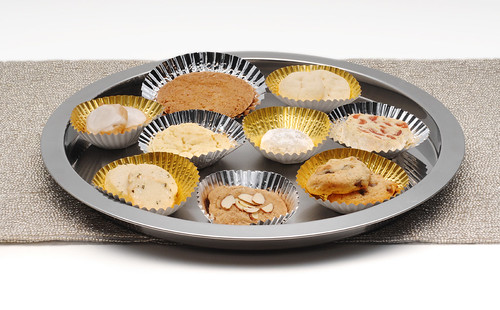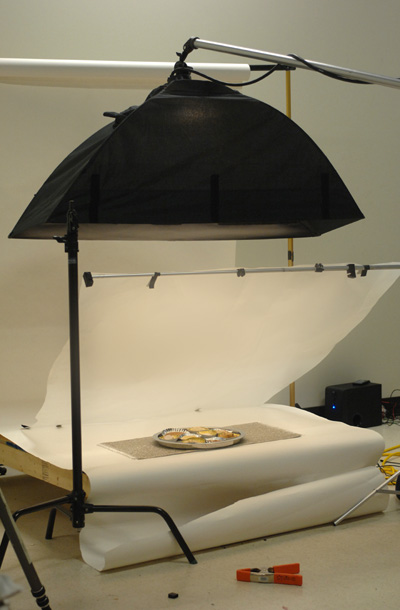 A while back, we looked at double diffusion as a means for controlling the surface reflections on glass bottles. Having recently talked about the concept of apparent light source size I wanted to revisit the technique and tie the two concepts together.
A while back, we looked at double diffusion as a means for controlling the surface reflections on glass bottles. Having recently talked about the concept of apparent light source size I wanted to revisit the technique and tie the two concepts together.The assignment was to shoot the winners of the holiday cookie bake-off for the food section at The Sun.
The cookies were all non-reflective and textured, ranging from light sugar cookies to dark ginger snaps. The page designer had chosen as her backdrop a shiny, stainless steel tray. To further expand my range of surfaces, she put the cookies in highly reflective foil baking cups.
This brings up an interesting exercise in light control. The cookies are going to eat the light. The steel is going to reflect it in a predictable manner. The foil cups are going to reflect back every light source in the room.
Before I get into the idea of double diffusion, lets back up to the concept of seeing the light source from the subject's perspective.
If you remember, it's the apparent size of the light source that matters. If you are unfamiliar with this concept, go back to the Dohrn piece to bone up.
 Here is the lighting setup. Imagine for a sec that you are a cookie on the tray and that the diffusion material (the translucent sheet tented over the cookies) is not there.
Here is the lighting setup. Imagine for a sec that you are a cookie on the tray and that the diffusion material (the translucent sheet tented over the cookies) is not there.When you look up from the tray, you are going to see a big softbox. I was in the studio, and needed mucho watt-seconds for lots of depth of field, so I was using a Profoto head in a softbox.
This softbox, coming from the top of the frame, is going to define the texture of the cookie as it lights it. All nice and smooth - no problems there.
Now, imagine you are the stainless steel platter. Not only are you going to see the big light source, but you are going to do something extra that the cookies do not do. You are going to reflect it right into the camera like a mirror.
And if the photographer gets out of the line of sight of the reflection, the tray will appear black. Not good.
But technically, the reflection of the softbox is not really a problem for the camera. It looks pretty cool, actually.
The problem comes where, on the steel tray, the reflection abruptly stops. We are talking about a near mirror-like surface, after all.
Again, remembering that you are still the stainless steel platter, try to imagine what you would see if the photographer stuck a sheet of diffusion material - in this case, Rosco Tuff Frost - between you and the light source.
You still reflect everything, and you are gonna throw back that softbox at the camera.
But now, instead of a sharp line where the softbox abruptly stops (within your field of view) you have a fuzzy, diffused edge to the light source. (Think of a window behind a shower curtain if it helps.)
Mind you, your reflective properties have not changed. And you are still going to throw back a faithful reflection of the light source. But the diffusion material has altered the appearance of the light source. So it has altered the reflection you are going to throw into the camera.
The final effect, from the camera's point of view, is to radically alter the apparent surface quality of the stainless steel. It is as if I had sprayed the tray with a dulling matte spray.
The quality of the light on the cookies is unaffected. They just need big, soft and directional. So they are happy.
(Hey, how could they not be happy? They are cookies. Everybody likes cookies.)
So now that we have tamed the (predictable) reflections in the stainless steel, what about the more complicated reflections in the foil?
Well, turns out this is pretty good solution for the foil, too.
You have a big apparent light source - the diffusion sheet itself. Which means that the light is spread out over a large area, so the intensity of the reflection will be modest and easy to manage, tonally speaking.
But also, the edges of the apparent light source are nice and fuzzy. So the reflections (technically, they are called "specular highlights") will have smooth transitions at the edges, too.
Let's back up now.
What we have is one hard light. We diffused it with a softbox to make a broad source. Then we diffused that with a sheet of translucent material to control the apparent edges of the broad light source.
Sounds more complicated that it is. Just look at the setup shoot, imagine you are the tray, and it should all make sense.
Here's the cookie photo at 1024-res, so you can see the light reflections - especially the transitions - more closely. That stainless steel looks like stainless steel should.
On a much sadder note, I had grand expectations for one important aspect of this shoot that went unmet. Tragically, while the cookies looked very good, they had been judged about a week before. So they were terribly stale.
So, all things taken into consideration, I would have to give this session very mixed reviews.
Next: How to Photograph Christmas Lights




0 comments:
Post a Comment